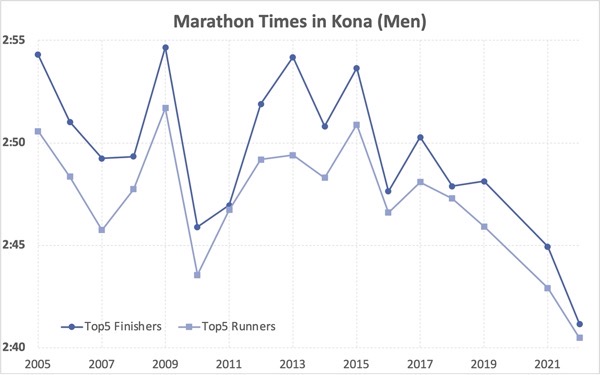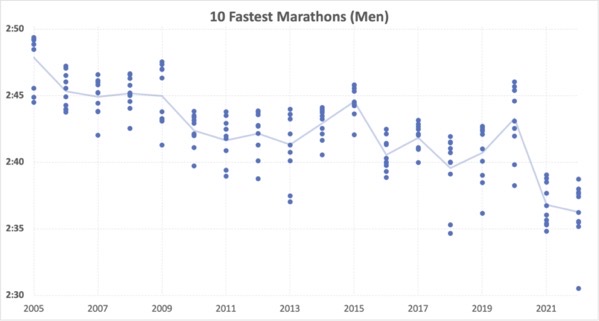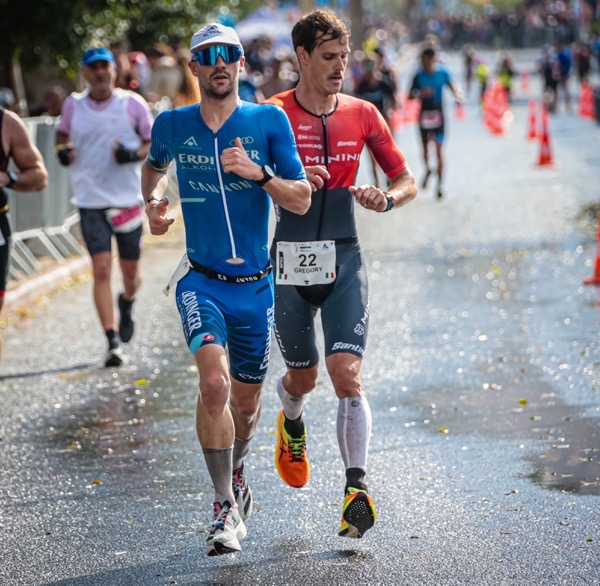The following post is an article written by Simon Mueller, originally in German for the leading German triathlon magazine “triathlon” (website tri-mag.de, German-language readers can also subscribe to print and digital version of the magazine). Many thanks to Simon and the triathlon publishers for letting me post this English version.
It was a year of records: 2022 saw an impressive performance leap on the long distance, both at the very top and across the field. We look at what performance, skills and requirements are necessary to have a chance for a podium in today’s big long-distance races.
TEXT > SIMON MUELLER
On May 6, 1954, Roger Bannister made sports history. On the track in Oxford, the Englishman was the first human to break the four-minute barrier for the mile, something that had previously been considered impossible. But Bannister’s world record of 3:59.4 minutes was short-lived. His fierce competitor John Landy ran a fantastic time of 3:58.0 minutes on June 21st. Shortly after, numerous other athletes entered the list of “Sub-4-Miler”. This is still the most obvious example of a shift in mental boundaries that resulted in an immediate performance leap in the entire sport. There have been countless other examples of athletes who made certain achievements tangible for the first time and thus significantly accelerated development. In 2022, triathlon might have reached such a point.
A Season of Superlatives
The past year had numerous results that show a rapid development in long-distance triathlon, both at the very top and across the field: Gustav Iden’s new Hawaii course record of 7:40:24, his run record of 2:36:11, Sam Laidlow’s bike record of 4:04:36 and Patrick Lange’s 2:30:32 marathon in his victory at Ironman Israel are a few examples of athletes reaching a completely new level. The most obvious case for a massive performance jump across the board: The first ten men in Hawaii finished under eight hours.
For triathlon, one has to ask how much of these improvements are a result of a higher performance (i.e. physiological improvements) and how much impact tactical considerations, external conditions and better equipment have. It is clear that an athlete has to master all these factors to make it onto the podium at the biggest races.
Higher Running Level and Changed Race Dynamics
Ironman Israel once again showed that it’s ever more difficult to win a long distance race even outside of the World Championships. Daniel Bækkegård had an exceptionally strong race, was six and a half minutes ahead of the chase group in T2, ran the following marathon in 2:37:40 – and was still caught by Patrick Lange in the end. There was speculation of a 2:30 marathon for many years. With his run split of 2:30:32, Patrick Lange was the first to achieve this spectacular feat. He surpassed the previous best times of Matt Hanson (2:34:39, Texas 2018) and Gustav Iden (2:34:50, Florida 2021) by several minutes. Will his marathon open the door for similar times in this year’s races? “I think I made a 2:40 marathon plausible back then. Nowadays you hardly win a big long-distance race if you don’t run in this region,” says Lange. (Full interview at the end.)
Running is now more important than ever. This is not only Lange’s perception but is also reflected in the data. Thorsten Radde from TriRating evaluated Hawaii results from 2005 to 2022. The following chart shows the average marathon times of the Top 5 overall finishers and Top 5 runners at each year’s Ironman Hawaii.

The average times started to become faster since 2015 – a development that is still continuing. You can also see that the lines are getting closer from year to year. The closer the lines are together, the more the top athletes have to be among the fastest runners to finish at the front. To put it the other way around: Where the lines are further apart, strong cyclists or swim-bikers had a better chance of finishing in the top five, even if they lost several minutes to the best runners in the marathon.
With the increased running level, this has become rare also due to the changed racing dynamics and the higher depth in the field. “Swimming has become much more important. Anyone who misses the top group in the water has almost no chance of winning,” says Björn Geesmann, coach of Patrick Lange and Katrina Matthews. He adds: “To have someone so strong on the bike to be able to make up several minutes and then still have a chance in the marathon – these days are over. The overall level at the top is too high for that. The only exception at the moment might be Magnus Ditlev.”
Last year, the top four in Hawaii came from the top group in swimming. Joe Skipper and Sebastian Kienle finished in fifth and sixth place, they were the first athletes from the chase group in the water. In past years, they or Cam Wurf were able to get to the front of the race. This year, they didn’t manage to get to the front of the race or the chase group behind Sam Laidlow on the bike. This fact underscores how crucial it has become to be at the front of the swim. And even if you can do that, in the end you also need the running ability already mentioned in the marathon to actually have a chance for the podium. Swimming and riding at the top is no guarantee for a top result. However, if you’re not at the front from the start, you’re no longer in the game. Interesting: The TriRating data does not show a similar development for the women – or maybe not yet.
Continuing Improvement in Marathon Times
Outside of Hawaii, marathon times for the men are also steadily improving. Thorsten Radde’s evaluations in the next graph show the distribution of the ten fastest marathon times in the respective years:

The 2020 outlier is not representative of the development because of fewer races during the corona pandemic. Leaving that year aside, it can be seen that both the fastest times and the average times have been improving steadily in recent times. The big leap last year is particularly noteworthy. The average of the ten fastest times was just over 2:36.
For the middle distance, on the other hand, the running times at the top have not changed for several years. Jan Frodeno’s half marathon in 1:06:34 at the 2018 Ironman 70.3 World Championships in South Africa is still the fastest run time to date on the middle distance and leaves little room for improvement. However, similar times have become more common, mainly due to short-distance athletes moving to longer distances. Examples include the half marathon splits by Kristian Blummenfelt (1:06:58) and Gustav Iden (1:07:13) in Bahrain 2018, Pierre Le Corre (1:07:08, 70.3 Les Sables 2022), Marten Van Riel (1:07:56, 70.3 Dubai 2022) and Jelle Geens (1:08:18, 70.3 Indian Wells 2021). Comparing different courses and conditions can be slippery, but a development in terms of performance density can also be seen here. Looking at result lists, victory in a strong middle distance is currently hardly possible without a half marathon time of at least 1:10 to 1:11 hours.
Impressive Top Rather Than Depth for the Women
The top 10 marathon times for women, on the other hand, have been at a similar level since 2010 and mostly fluctuate between 2:54 and 2:58 hours. In recent years there have been a few exceptional individual performances such as Laura Philipp’s 2:44 and 2:45 marathons in Klagenfurt and Hamburg as well as Anne Haug’s 2:46 in Roth or Katrina Matthews’ 2:49 in Tulsa. In terms of overall times, one athlete was way ahead of her time: Chrissie Wellington set a world best of 8:18:13 in 2011 which still stands today. In addition, the Briton also holds the third fastest long-distance time of 8:19:13. In between there is Laura Philipp, her 8:18:20 at Ironman Hamburg 2022 indicated that there could be a similar development for women in the next few years. Daniela Ryf’s long-term dominance is a good example of the fact that the depth among the top women was not yet at a comparable level to that of men. But the results of the past two years have shown that Daniela Ryf is no longer a step above everyone else on the long distance.
4 Watts per kg for 180 Kilometers
In addition to the ability to reach the first swimming group and to achieve one of the fastest run times in the end, the necessary requirements are quite explicit: “In the long distance, the men have to be able to pedal four to 4.2 watts per kilogram of body weight over the 180 kilometers,” estimates Björn Geesmann. Sam Laidlow averaged 311 watts during his bike course record in Hawaii. The old mark was set by Cameron Wurf in 2018 with a power of 296 watts. As a comparison: Lionel Sanders produced 308 watts at Ironman Hawaii 2017. Aerodynamics plays a crucial role here. Björn Geesmann speaks of power in relation to the CdA value, which represents the rider’s air resistance: “Ultimately, it’s about speed. Power to weight is therefore not the decisive factor, especially on flat courses. It is often much more important that you can achieve the highest possible power with the lowest possible CdA value.” In this area, the sport has become much more professional in recent years: “The faster bike times across the field certainly are not a result of higher power but because of improved aerodynamics,” says the coach.
This overall development makes it clear that you have to be a very good athlete in all disciplines if you want to win renowned long- or middle-distance races. Gone are the days when uber-bikers or athletes with a very strong bike-run combination made it to the front in big races after swimming deficits of several minutes. Rather, important preliminary decisions are made while swimming and cycling. For all athletes who are within striking distance at T2, the running times decide the positions at the end. The overall winner often has the best time of the day in the marathon or half marathon. Successful solo breakaway attempts are – at least for the men – only rarely successful. As the races in Israel or Hawaii have already shown, even a lead of several minutes after cycling has to be followed by an exceptionally strong run performance. It’s interesting whether a selective bike course such as the Ironman World Championships in Nice can change this unwritten law.
“2:30 has been on my mind for years”
Patrick Lange won Ironman Israel in November 2022 running on another level. He finished the closing marathon in 2:30:32 (average speed of 3:34 minutes per kilometer or 5:39 minutes per mile), significantly faster than any other long-distance athlete before him. We spoke with the two-time Ironman World Champion about his record run, important circumstances, his run training and performance development in the third discipline.
Patrick, your marathon time of 2:30:32 at Ironman Israel was a performance jump rarely seen in triathlon. Were you surprised as well or did you think that was possible before the race?
There was a session before the race in which I felt the perfect interaction between my race shoe and my running form. It was a 90-minute brick run where I could easily change the pace between 3:15 and 3:30 per kilometer. After that I figured there could be a very fast marathon in Israel if everything comes together there. But very fast for me was more like 2:33 or 2:34 hours at best. I would never have thought that the run could get so much faster than that.
In recent years, the marathon in or under 2:30 hours has repeatedly been put forward by many as the next big goal. Were you sceptical about such statements or did you see the potential for them?
It’s not that we didn’t analyze it carefully beforehand, but I was surprised that I pulled it off in Israel. With my trainer Björn Geesmann and especially with my running coach Wolfgang Schweim, we looked for several years at factors that can make me faster and where the limit might be under optimal circumstances. In these conversations, 2:30 hours were often mentioned, even if only hypothetically. That’s why this time has been in the back of my mind for quite some time, although it was never a specific goal. Regardless, I assumed it was only a matter of time before someone did.
At what point in the race did you realize you could keep up the pace to the end?
That was at kilometers 25 and 26. I ran these two kilometers in about 3:20 minutes, at some point I accelerated to almost 3:00 minutes per kilometer pace for 400 meters to get rid of Gregory Barnaby.

(Photo Credit: © Ingo Kutsche)
And that’s my first explanation of how this time came about: No one follows my every step for more than ten kilometers or even a half marathon. I could hear his breathing all the time. As a result, I got a little nervous. Mainly because I didn’t even know him until then. So I called out to Björn during the race to google who that was. When I decided to attack him, Daniel Bækkegård was in the lead and I had to keep the pressure up. After I passed him, the gap increased only slowly and he was just behind me the whole time. That’s why I didn’t look at the clock anymore, I just tried to keep up the pace until the end. I haven’t had this tactically favorable constellation in any other race so far. The fact that I was under pressure for so long from a direct competitor at high speed and at the same time someone was still in front of me certainly meant that I was able to make so much out of it.
Are there other factors that favored this pace?
Yes, nutrition, the dynamics of cycling and my race shoe certainly made a contribution. I managed to eat 90 grams of carbs or more per hour on the bike – the first time in a long distance race. On top of that, it was very even cycling for me. I quickly realized that nobody in the chase group really wanted to take the lead. I accepted that and rode at the front for most of the time. As a result, I was able to stay within my power range for the entire distance, to put out my 260 watts fairly constantly and didn’t have any peaks. Thanks to this combination, at the start of the marathon I was probably in a better position energetically than ever before.
You have already mentioned changing your race shoe.
I ran the “Prime X” from Adidas, I hadn’t worn that model for a long distance before. It was the last chance because the shoe is banned from this season due to the new competition regulations. We tested various running shoes under laboratory conditions and found that the Prime X was the best and most efficient. Compared to my usual race shoe, the difference is only minimal. Because of the run course in Israel I decided to wear it there. In retrospect, of course, one cannot say exactly how big the influence actually was. If you consider that as an additional plus point, it will be missing in the future at first.
All of this doesn’t sound like you’ve been in significantly better run shape. What was your running training like in preparation and where were you compared to previous years?
Sure, I was in great shape, but we weren’t able to determine a significant performance improvement based on the training data beforehand – probably my previous level was too good for that. Many of the sessions appear again and again in every preparation and were absolutely comparable. I’m not one to run incredibly high volume in training. In active weeks I ran about 75 to 85 kilometers. There are also no monster sessions in my training. For me, consistency is the key to success.
Immediately after switching to long-distance in 2016, you ran very fast and with a time of 2:39:45 broke the run course record in your Hawaii debut. Back then you were coached by Faris Al-Sultan. How does your current run training differ from the approach back then?
The training with Björn Geesmann is considerably more specific. Back then, I ran practically all my long-distance runs faster than four minutes per kilometer and there were always really tough interval sessions, where I ran 1,000-meter intervals in three minutes, for example. I now run the easy sessions more slowly. But three-quarters of the runs have specific programs with the goal to become more economical. In almost every training session, I’m roughly at the target long-distance pace for some of the time, but I hardly ever run high-intensity intervals anymore. I think that explains why, even coming from an already high level in the years before Israel, I improved by several minutes in the marathon.
Do you think that your 2:30:32 could open the door for other athletes to follow suit and for the run times at the top and across the field to noticeably improve in the future?
I think I made a 2:40 marathon plausible back then. Nowadays you hardly win a big long-distance race if you don’t run in this region. But I can imagine that something else is going to happen there. But as long as that’s not the case, I’m happy to use this mental advantage for myself.
Pingback: Carefully Curated Triathlon News for April 6, 2023 - TriathlonWire
Comments are closed.